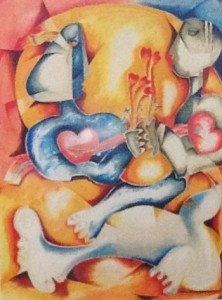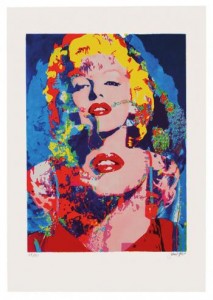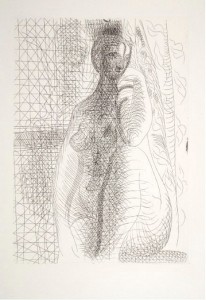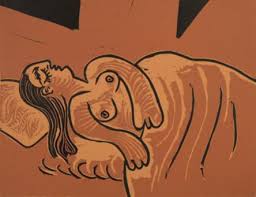Do you know the difference between a lithograph and a serigraph? What do you etch when creating an etching? How does a linocut work? If you are not an artist, then you may not immediately know the answers to these questions. However, anyone who collects fine art naturally has an interest in the methods of creation and the effort that goes into creating each and every piece. Here are a few definitions of common fine art types of print mediums.
Lithograph
Lithography is a one of the types of print mediums that involves the process of applying a design onto any material. An artist creates a drawing with wax crayons on limestone or textured aluminum. Ink is then applied to the stone with a roller. The ink sticks to the elevated wax layer, then the weight of the stone is used to press the image onto paper. Today, lithographs are often created using a machine that uses a four color separation process, much in the way that a magazine is printed.
Serigraph
A serigraph is a work that is produced by using a screen printing method that applies the ink with a silkscreen, although today polyester and nylon are more common textiles. An original oil painting is scanned and the colors are separated digitally. A separate silkscreen is created for every single color in the painting, which can typically reach a maximum of 80 to 130 individual colors. Each individual silkscreen is applied to the serigraph paper, and the artist then smooths the paint over the screen using a hand squeegee. After this, the paper must be left to dry before the next layer of color can be added. This process is very meticulous and can take months at a time just to produce one run of serigraphs. Serigraphs also tend to be the truest copy of the original work since each color is meticulously reproduced by hand.
Etching
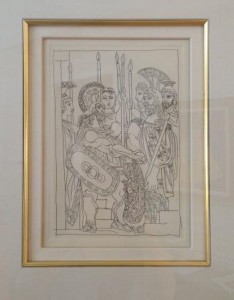
“Accord Entre Les Guerriers de Sparta et d’ Athens”
Picasso
Etching
1934
6 X 9″ Framed size: 22″ X 25″
Etching is one of the types of print mediums that involves applying an image to metal. With engraving, an image is cut into a metal sheet. With etching, the metal sheet is covered in a layer of wax. An image is then traced into the wax and an acid is used to burn the exposed metal. The pliability of the wax allows for more subtle lines and shading. Repeated masking of certain areas of the etch using a painted-on varnish or lacquer and re-applied washes of acid create more intense depth and tone. The resulting image takes on a the fine softness of a pencil drawing.
Linocut
A linocut is similar to a woodcut, except that instead of using wood the artist uses linoleum. Since linoleum has no directional wood grain, it allows the artist more freedom to create elaborate images. An image is cut into the linoleum using several special tools, then the linoleum is painted with an ink roller, and then the linoleum is pressed onto paper or fabric. This can be done by hand or machine. The resulting work is a mirror image of the original.
Keep up with our blog for the latest art news.
Questions? Call Patty Barnett at 504.524.2922
Like us on Facebook and follow us on Twitter and share with your friends.
Tags: etching, fine art, linocut, lithograph, print mediums, serigraph






